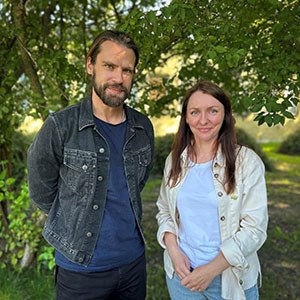Ukraine's apple heritage is threatened – SLU research provides crucial answers

Following insistent detective work, researchers have been able to extensively map out the family trees connecting many varieties of Swedish apples. This has helped clarify the relationships between different heritage varieties and is a boon for optimising plant breeding. This research is now being used to preserve domestic heritage varieties in war-torn Ukraine.
Apples are primarily grown in southern Sweden, compared to Ukraine which boasts fertile soil with orchards all across the country.
– Apples are one of our main exports, explains Kateryna Udoyychenko, postdoctoral researcher at SLU since June 2023.
The war has struck the apple industry of Ukraine hard. Aside from purely material damage – which has destroyed orchards – there is also a shortage of manpower due to workers being mobilised for the war effort. Furthermore, the prices for fertilizer and fuel has soared. Combined with worsened export prospects, this leaves Ukrainian farmers vulnerable.
– Many apple farmers faces difficulties, and are now looking for new opportunities, diversification and optimization of production processes.
Research also withers under the shadow of war.
– One of our research stations for the preservation of heritage varieties has been destroyed, and another is inside occupied territory.
Kateryna Udoyychenko emphasises that historical apple varieties in Ukraine are under real threat. This is a situation that she hopes to change for the better through her work at SLU. In order to preserve these varieties however, she first needs to catalogue them. In order to do so, she is currently analysing DNA samples from some 150 Ukrainian trees.
– I have already found several mislabelled varieties and duplicates.
Guiding her is fellow postdoctoral researcher Jonas Skytte af Sätra, who developed methods for genome-based selection for use in plant breeding instead of phenotype-based selection for his doctoral thesis. Put into practice, this allows for the use of DNA-based tools to identify suitable parents early on in the plant breeding process. The offspring is then checked for whether or not it has inherited the desired qualities from its parents. DNA-based selection allows breeders to select desirable parents and target specific qualities such as resistance to fruit tree canker (FTC). Unpromising plant material can then be safely disregarded, in favour of more promising offspring.
The genetic material of apples is comparatively small in size. Less than a fourth of that of humans, explains Jonas Skytte af Sätra.
– This relatively small genetic material is much easier to work with compared to something like conifers, where the genetic sequences are much longer.
The work to trace the lineages of heritage varieties back through time via a delicate weave of mutual relationships is still extensive and by no means easy, despite the humble size of the genetic material. By analysing DNA from a smaller part of the tree such as the leaves, researchers are able to pinpoint the ancestry and qualities of any single tree. Of particular interest to Jonas Skytte af Sätra is resistance to the fungal disease fruit tree canker (FTC).
– The goal is to expand our research to identify more properties, and get a more complete picture of which properties are carried by different apple varieties.
These properties aren’t limited to FTC resistance. They can also encompass characteristics such as acidity and consistency inherent in different varieties.
– We’ve reached a stage where we have a good base of knowledge to start from, when tracing these properties.
Kateryna Udovychenko hopes that her time at SLU will yield important answers about the genetic structure of the Ukrainian apple varieties. With this knowledge, the aim is to optimise the country’s genetic sample banks for preservation of domestic heritage varieties. With the work she has done so far, she can already see the need to gather further plant material.
– I will return to Ukraine to bring back more samples, she says, emphasising that she will limit her trip to areas that are safe to visit. Although she cautions that perhaps there are no areas in Ukraine today that can be said to be truly safe.
Links:
More articles on apples: slu.se/apple